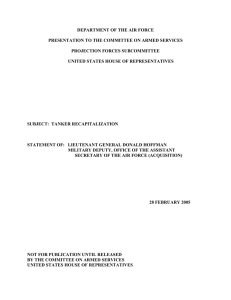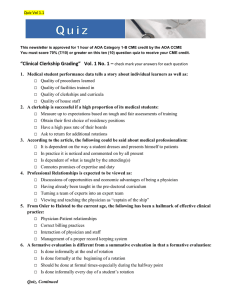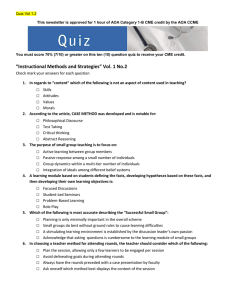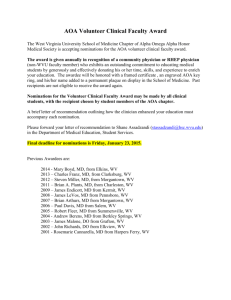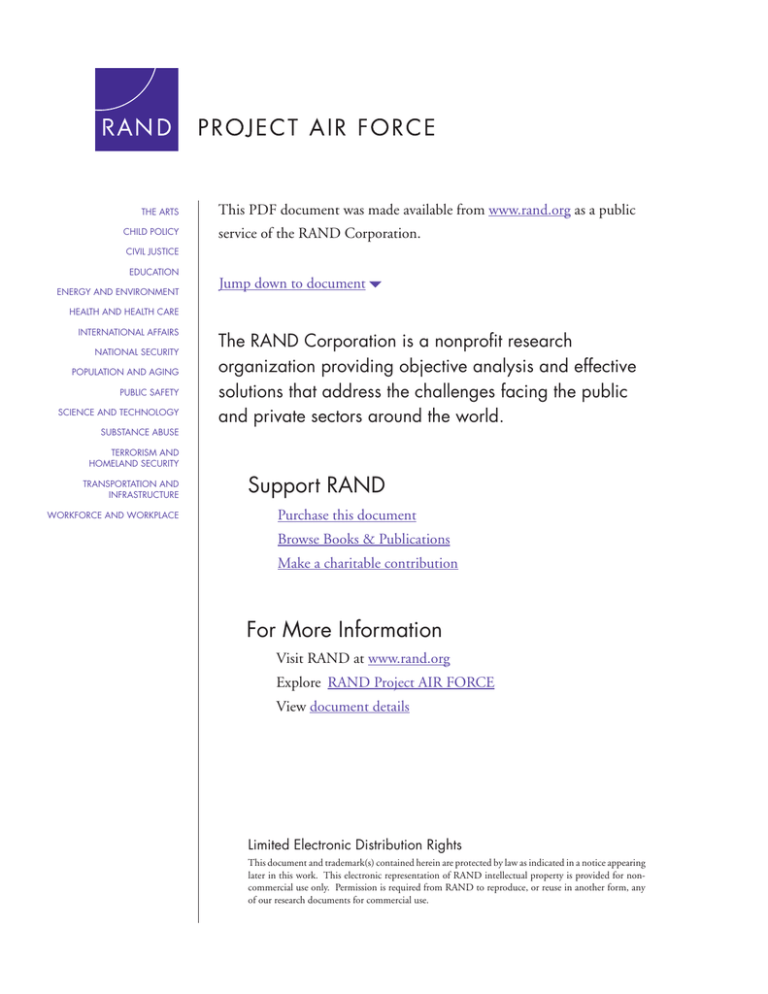
THE ARTS
CHILD POLICY
This PDF document was made available from www.rand.org as a public
service of the RAND Corporation.
CIVIL JUSTICE
EDUCATION
ENERGY AND ENVIRONMENT
Jump down to document6
HEALTH AND HEALTH CARE
INTERNATIONAL AFFAIRS
NATIONAL SECURITY
POPULATION AND AGING
PUBLIC SAFETY
SCIENCE AND TECHNOLOGY
SUBSTANCE ABUSE
The RAND Corporation is a nonprofit research
organization providing objective analysis and effective
solutions that address the challenges facing the public
and private sectors around the world.
TERRORISM AND
HOMELAND SECURITY
TRANSPORTATION AND
INFRASTRUCTURE
WORKFORCE AND WORKPLACE
Support RAND
Purchase this document
Browse Books & Publications
Make a charitable contribution
For More Information
Visit RAND at www.rand.org
Explore RAND Project AIR FORCE
View document details
Limited Electronic Distribution Rights
This document and trademark(s) contained herein are protected by law as indicated in a notice appearing
later in this work. This electronic representation of RAND intellectual property is provided for noncommercial use only. Permission is required from RAND to reproduce, or reuse in another form, any
of our research documents for commercial use.
This product is part of the RAND Corporation monograph series. RAND monographs present major research findings that address the challenges facing the public
and private sectors. All RAND monographs undergo rigorous peer review to ensure
high standards for research quality and objectivity.
Analysis of Alternatives
(AoA) for KC-135
Recapitalization
Executive Summary
Michael Kennedy, Laura H. Baldwin, Michael Boito, Katherine M. Calef,
James S. Chow, Joan Cornuet, Mel Eisman, Chris Fitzmartin,
Jean R. Gebman, Elham Ghashghai, Jeff Hagen, Thomas Hamilton,
Gregory G. Hildebrandt, Yool Kim, Robert S. Leonard, Rosalind Lewis,
Elvira Loredo, Daniel M. Norton, David T. Orletsky, Harold Scott Perdue,
Raymond A. Pyles, Timothy L. Ramey, Charles Robert Roll, Jr.,
William Stanley, John Stillion, Fred Timson, John Tonkinson
Prepared for the United States Air Force
Approved for public release; distribution unlimited
The research reported here was sponsored by the United States Air Force under Contract
F49642-01-C-0003. Further information may be obtained from the Strategic Planning
Division, Directorate of Plans, Hq USAF.
The RAND Corporation is a nonprofit research organization providing objective analysis
and effective solutions that address the challenges facing the public and private sectors
around the world. RAND’s publications do not necessarily reflect the opinions of its
research clients and sponsors.
R® is a registered trademark.
© Copyright 2006 RAND Corporation
All rights reserved. No part of this book may be reproduced in any form by any electronic
or mechanical means (including photocopying, recording, or information storage and
retrieval) without permission in writing from RAND.
Published 2006 by the RAND Corporation
1776 Main Street, P.O. Box 2138, Santa Monica, CA 90407-2138
1200 South Hayes Street, Arlington, VA 22202-5050
201 North Craig Street, Suite 202, Pittsburgh, PA 15213-1516
RAND URL: http://www.rand.org/
To order RAND documents or to obtain additional information, contact
Distribution Services: Telephone: (310) 451-7002;
Fax: (310) 451-6915; Email: order@rand.org
iii
Preface
In a February 24, 2004, memorandum to Secretary of the Air Force James Roche, Michael W.
Wynne, Acting Under Secretary of Defense, Acquisition, Technology and Logistics, directed that
an Analysis of Alternatives (AoA) for KC-135 Recapitalization be undertaken. He also specified
that a federally funded research and development center or other independent agency conduct
the study and that a Senior Steering Group, chaired by Dr. Glenn F. Lamartin, Director of Defense
Systems in the Office of the Under Secretary of Defense, Acquisition, Technology and Logistics,
be established to “guide and direct the work of the AoA.” A subsequent memorandum, dated
May 25, 2004, changed the original completion date of July 2005 to November 2004. At the first
Senior Steering Group meeting, held on May 28, 2004, RAND Project AIR FORCE was chosen to
conduct the AoA. The completion date was subsequently extended until December 2004.
A draft report of some 1,500 pages was delivered to the Senior Steering Group in December 2004.
At a subsequent Senior Steering Group meeting on January 25, 2005, it was decided that
additional work should be done on the AoA. In a memorandum dated February 28, 2005, to
Secretary Roche, Mr. Wynne directed that additional work be done on the AoA. A revised draft
report was delivered to the Senior Steering Group in August 2005. Between August and
December 2005, this draft then underwent a Sufficiency Review conducted by the Office of the
Secretary of Defense, Program Analysis and Evaluation. At the same time, it underwent a
methodology and objectivity review by the Institute for Defense Analyses. These two reviews led
to additional sensitivity analyses. A third-round draft final report, of some 1,900 pages, was
delivered to the Senior Steering Group in December 2005.
RAND Project AIR FORCE
RAND Project AIR FORCE (PAF), a division of the RAND Corporation, is the U.S. Air Force’s
federally funded research and development center for studies and analyses. PAF provides the Air
Force with independent analyses of policy alternatives affecting the development, employment,
combat readiness, and support of current and future aerospace forces. Research is conducted in
four programs: Aerospace Force Development; Manpower, Personnel, and Training; Resource
Management; and Strategy and Doctrine. Integrative research projects and work on modeling
and simulation are conducted on a PAF-wide basis. The research reported here was prepared
within the PAF-wide program.
Additional information about PAF is available on our Web site at http://www.rand.org/paf.
v
Contents
Preface............................................................................................
iii
Foreword .........................................................................................
1
EXECUTIVE SUMMARY........................................................................
Introduction ................................................................................
History and Organization of the AoA .....................................................
Research Questions and Approach ........................................................
Assessing the Cost-Effectiveness of Alternatives........................................
Assessing the Timing of Recapitalization................................................
Sensitivity Analysis .......................................................................
Findings ....................................................................................
Cost-Effectiveness of Alternatives .......................................................
Two Additional Considerations..........................................................
Timing of Recapitalization ...............................................................
Technical Condition of the KC-135 Fleet.................................................
Conclusion..................................................................................
3
3
3
7
7
10
11
12
12
14
14
15
16
1
Foreword
Consistent with the Department of Defense Acquisition directive, on February 24, 2004, the
Acting Under Secretary of Defense, Acquisition, Technology and Logistics (USD(AT&L)),
directed the Air Force to conduct an Analysis of Alternatives (AoA) for the recapitalization of the
KC-135 aerial refueling tanker. In his guidance, he defined the set of alternatives and the basic
assumptions for the analysis. He also established a Senior Steering Group, chaired by the Director
of Defense Systems in USD(AT&L), to oversee the AoA process. The Senior Steering Group
membership was drawn from a wide number of offices in the Office of the Secretary of Defense,
Air Force, Navy, Marine Corps, Army, and combatant commands. The Senior Steering Group
began planning for the effort, drafting and coordinating a study plan, and took measures to
ensure both widespread participation in the study process and extensive independent review of
its analysis and findings.
On May 25, 2004, the Acting USD(AT&L) directed that the AoA schedule be accelerated from its
original due date of July 2005 to November 2004. Consistent with congressional direction that a
federally funded research and development center (FFRDC) or other independent agency
conduct the study, on May 28, 2004, the Senior Steering Group approved the selection of RAND
Project AIR FORCE (PAF) to perform the AoA.
Working-level integrated product teams—with representatives from Senior Steering Group
organizations—met almost weekly to work with RAND PAF in formulating, implementing, and
validating the research throughout the process. These meetings ensured that RAND could receive
data and resolve any concerns quickly and that the department could understand the analysis
and ask questions as the AoA progressed.
After RAND PAF submitted its AoA report to the Senior Steering Group in December 2004,
Acting USD(AT&L) determined additional time was warranted for additional analysis.
Additional sensitivity analysis did not result in any material changes to the findings of December
2004. It did, however, greatly increase the Defense Department’s confidence in the findings, as
the additional work showed that they were robust to a wide set of alternative projections of
future conditions. The final results were submitted in December 2005, and this Executive
Summary describes them. A final report of some 1,900 pages was delivered in March 2006.
Two distinct independent review efforts of this AoA were conducted. In accordance with the
acquisition directive, the Program Analysis and Evaluation (PA&E) directorate of the Office of
the Secretary of Defense conducted a Sufficiency Review of the AoA. Additionally, the Institute
for Defense Analyses (IDA), also an FFRDC, conducted an objectivity and methodology review as
a second check. PA&E and IDA analysts gained early insights on their review activities during
2
the research process, since they participated in the working-level integrated product teams. They
began their final comprehensive reviews when a draft final report was submitted in August 2005.
PA&E found that the AoA met the Sufficiency Review standards and criteria, and IDA found that
the AoA was objective and conducted with sound methodology.
The Defense Department has high confidence that the results of this AoA, reported in this
Executive Summary, are robust and provide a sound basis for KC-135 recapitalization.
Diane M. Wright
Deputy Director, Air Warfare
OUSD(AT&L)
3
Executive Summary
Introduction
Recapitalization of the KC-135 aerial refueling tanker is very important for U.S. national security
and has a significant impact on the U.S. national budget. Aerial refueling tankers are a critical
part of U.S. military and national security strategy. Without them, air power cannot be deployed
to overseas theaters in a timely way; it cannot be operated at militarily required distances from
overseas bases; U.S.-based strategic air forces cannot execute overseas missions; and homeland
defense air patrols would lose substantial effectiveness. The KC-135 constitutes the bulk of the
current tanker force, embodying about 80 percent of U.S. aerial refueling capability. The KC-135
fleet is nearing 50 years of age, and it has exhibited some technical difficulties and increased costs
of operation. KC-135 recapitalization also has major budgetary implications. The total cost of both
operating the KC-135s until they are retired and acquiring and operating their replacements is in
the $200 billion range over the next half century.
This AoA addressed the cost-effectiveness of a wide range of alternatives for KC-135
recapitalization, including a large number of replacement systems and replacement schedules. In
this AoA, the most “cost-effective” alternative means precisely the alternative whose effectiveness meets
the military aerial refueling requirement at the lowest cost. The AoA primarily used requirements
from the Defense Department’s Mobility Capabilities Study, which was completed in 2005.
History and Organization of the AoA
In a February 24, 2004, memorandum to Secretary of the Air Force James Roche, Michael W.
Wynne, then Acting Under Secretary of Defense, Acquisition, Technology and Logistics
(USD(AT&L)), directed that an AoA for KC-135 Recapitalization be undertaken. He also specified
that a federally funded research and development center or other independent agency conduct
the study and that a Senior Steering Group, chaired by Dr. Glenn F. Lamartin, Director of Defense
Systems under USD(AT&L), be established to “guide and direct the work of the AoA.”1 A
________________
1 The Senior Steering Group included members from the following organizations: Office of the Under Secretary of
Defense, Acquisition, Technology and Logistics, Defense Systems; Office of the Under Secretary of Defense, Acquisition,
Technology, and Logistics, Acquisition Resources and Analysis; Office of the Secretary of Defense, Director of
Operational Test and Evaluation; Office of the Secretary of Defense, Director of Program Analysis and Evaluation; Office
of the Assistant Secretary of Defense, Network and Information Integration; Joint Chiefs of Staff, Director for Force
Structure, Resources, and Assessment; U.S. Army; U.S. Navy; U.S. Air Force; U.S. Marine Corps; and U.S. Transportation
Command.
The Senior Steering Group also included observers from the following organizations: Air Mobility Command; Office
of the Secretary of Defense, Comptroller; Office of the Secretary of Defense, Office of General Counsel; Office of the
4
subsequent memorandum, dated May 25, 2004, changed the original deadline of July 2005 to
November 2004. The deadline was subsequently extended by the Senior Steering Group to
December 2004. At its first meeting, held on May 28, 2004, the Senior Steering Group approved
RAND Project AIR FORCE (PAF) to conduct the AoA. 2
At this first meeting, the Senior Steering Group also directed that an Integrating Integrated
Product Team be established under the co-chairmanship of Diane M. Wright, Deputy Director of
Defense Systems (Air Warfare) in OUSD(AT&L) and Col Paul Stipe, Deputy Director of Global
Reach Programs in the Air Force Secretariat (SAF/AQQ), to provide day-to-day guidance for the
AoA. 3 Col John Brunderman, Chief of the Mobility Division in the Directorate of Global Reach
Programs (SAF/AQQM), subsequently replaced Colonel Stipe.
At its first meeting on June 7, 2004, the Integrating Integrated Product Team adopted the
organizational structure illustrated in Figure 1.
For this AoA, the Senior Steering Group provided overall guidance, and the Integrating
Integrated Product Team provided day-to-day guidance. RAND Project AIR FORCE led the
research effort. The Alternatives, Effectiveness, and Cost Integrated Product Teams assisted
RAND by reviewing the overall research approach and results and by providing many specific
inputs on the assessment of the performance and cost characteristics of the alternatives.4
_____________________________________________________________________________________
Secretary of Defense, Legislative Affairs; Office of Management and Budget; and Office of the Assistant Secretary of the
Air Force for Acquisition.
2 Before May 28, 2004, a decision had not been made regarding who would carry out the study. Therefore, no one
from the RAND Corporation attended this meeting.
3 The Integrating Integrated Product Team included members from the following organizations: Office of the Under
Secretary of Defense, Acquisition, Technology and Logistics; Air Mobility Command; U.S. Transportation Command;
Joint Chiefs of Staff, Director for Logistics; Joint Chiefs of Staff, Director for Force Structure, Resources, and Assessment;
Office of the Assistant Secretary of the Air Force for Financial Management; Air Force Cost Analysis Agency; Office of the
Assistant Secretary of the Air Force for Acquisition; Deputy Chief of Staff of the Air Force, Installations and Logistics;
Deputy Chief of Staff of the Air Force, Warfighting Integration; Deputy Chief of Staff of the Air Force, Air and Space
Operations; Deputy Chief of Staff of the Air Force, Plans and Programs; Air Force Studies and Analysis Agency; Office of
Aerospace Studies, Air Force Materiel Command; Office of the Secretary of Defense, Director of Operational Test and
Evaluation; Office of the Secretary of Defense, Comptroller; Office of the Under Secretary of Defense, Acquisition,
Technology and Logistics, Defense Industrial Policy; U.S. Army; U.S. Navy; Office of the Secretary of Defense, Director of
Program Analysis and Evaluation; RAND Corporation; and Institute for Defense Analyses.
4 The Alternatives Integrated Product Team included members from the following organizations: Air Force
Research Laboratory; Aeronautical Systems Center, Air Force Materiel Command; Air Mobility Command; U.S.
Transportation Command; Office of the Secretary of Defense, Director of Program Analysis and Evaluation; Joint Chiefs
of Staff, Director for Force Structure, Resources, and Assessment; Office of Aerospace Studies, Air Force Materiel
Command; Office of the Assistant Secretary of the Air Force for Acquisition; Office of the Assistant Secretary of the Air
Force for Financial Management; Deputy Chief of Staff of the Air Force, Installations and Logistics; Deputy Chief of Staff
of the Air Force, Warfighting Integration; Deputy Chief of Staff of the Air Force, Air and Space Operations; Deputy Chief
of Staff of the Air Force, Plans and Programs; U.S. Navy; U.S. Army; Air Combat Command; and Office of the Under
Secretary of Defense, Acquisition, Technology and Logistics.
The Effectiveness Integrated Product Team included members from the following organizations: Air Mobility
Command; U.S. Transportation Command; Office of the Secretary of Defense, Director of Program Analysis and
Evaluation; Joint Chiefs of Staff, Director for Force Structure, Resources, and Assessment; Office of Aerospace Studies, Air
Force Materiel Command; Office of the Assistant Secretary of the Air Force for Acquisition; Office of the Assistant
Secretary of the Air Force for Financial Management; Deputy Chief of Staff of the Air Force, Installations and Logistics;
Deputy Chief of Staff of the Air Force, Warfighting Integration; Deputy Chief of Staff of the Air Force, Air and Space
Operations; Deputy Chief of Staff of the Air Force, Plans and Programs; U.S. Navy; U.S. Army; Air Combat Command;
and Office of the Under Secretary of Defense, Acquisition, Technology and Logistics.
5
Figure 1
Organizational Structure of the AoA
Senior Steering
Group
Integrating Integrated
Product Team
RAND
Lead
Alternatives
Integrated Product
Team
Effectiveness
Integrated Product
Team
Cost
Integrated Product
Team
RAND MG495-1
In addition to the meeting on May 28, 2004, the Senior Steering Group met six more times
between June 2004 and July 2005. There were 36 Integrating Integrated Product Team meetings
during that period, approximately three per month. During the same period, the Alternatives and
Effectiveness Integrated Product Teams each met four times, and the Cost Integrated Product
Team five times.
The RAND research team had extensive additional interaction with many persons and
organizations cognizant of tanker policy issues. In particular, the heads of the Alternatives and
Effectiveness Integrated Product Teams held regular meetings with Office of the Secretary of
Defense, Program Analysis and Evaluation analysts to discuss analytic issues. USD(AT&L)
contracted with the Institute for Defense Analyses to review the methodology and objectivity of
the AoA while it was under way. This review process began in July 2004, with the participation
_____________________________________________________________________________________
The Cost Integrated Product Teams included members from the following organizations: Air Mobility Command;
Aeronautical Systems Center, Air Force Materiel Command; Air Force Cost Analysis Agency; Headquarters, Air Force
Materiel Command; Office of the Assistant Secretary of the Air Force for Acquisition; Deputy Chief of Staff of the Air
Force, Air and Space Operations; Air Force Studies and Analysis Agency; Oklahoma City Air Logistics Center; Office of
Aerospace Studies, Air Force Materiel Command; Office of the Under Secretary of Defense, Acquisition, Technology and
Logistics, Defense, Industrial Policy; U.S. Army; U.S. Navy; Office of the Secretary of Defense, Director of Program
Analysis and Evaluation; and Office of the Under Secretary of Defense, Acquisition, Technology and Logistics.
6
of the Institute for Defense Analyses in the integrated product teams, and ended with a detailed
evaluation of the final RAND analysis.
The RAND research team had extensive interactions with representatives of industry and other
organizations. In response to a series of requests for data, Boeing, the European Aeronautic
Defence and Space Company, Lockheed Martin, and Northrop Grumman proposed many of the
specific alternatives assessed in the AoA. The RAND research team had several meetings with
personnel from each of these companies covering a broad range of topics, including preferred
aircraft configurations, performance data, and cost data. The RAND research team received data
from, and discussed issues with, representatives of the engine manufacturers, General Electric
and Pratt & Whitney.
The Air Force’s Aeronautical Systems Center, part of Air Force Materiel Command, proposed
three new-design tankers that were included in the AoA and made significant contributions to
the AoA’s technical assessments of all the alternatives. The Air Mobility Command’s Studies and
Analysis Division (AMC/A59) made significant contributions to the AoA’s effectiveness analysis,
especially in the detailed modeling of tanker operations.
The RAND research team discussed issues relating to used-aircraft acquisition and conversion
and commercial sources of refueling within the continental United States with staff from the
following companies and organizations:
•
United Kingdom Ministry of Defence and AirTanker (regarding the Future Strategic Tanker
Aircraft program and the associated Private Finance Initiative)
•
Omega
•
Evergreen (regarding acquisition and conversion of used aircraft and the Global Airtanker
Service, in which they were then a partner)
•
Federal Express
•
Atlas
•
International Air Systems
•
Consolidated Air Support Systems.
The AoA was completed within the prescribed six months, and a draft final report was delivered
to the Senior Steering Group in December 2004. After staff review of the analysis, the Senior
Steering Group decided at its meeting on January 25, 2005, that there was time for important
additional work to be done on the AoA. The additional work would provide depth that was not
possible given the initial accelerated time frame of the AoA. In a memorandum dated February
28, 2005, to Secretary Roche, Mr. Wynne directed that the additional work be done. A new draft
final report that included the additional work was delivered to the Senior Steering Group in
August 2005. Between August and December 2005, the Office of the Secretary of Defense,
7
Program Analysis and Evaluation, completed its Sufficiency Review of the AoA. At the same
time, the Institute for Defense Analyses completed its independent review of the AoA’s
methodology and objectivity. These two reviews led to some additional analysis during the
review period, primarily in the form of additional sensitivity analyses. A final draft report that
included the additional analysis requested during the review period was delivered to the Senior
Steering Group in December 2005.
This executive summary presents the overall findings of the AoA. Specific data supporting the
findings, much of which is proprietary or otherwise restricted, is contained in the 16-volume,
1,900-page final report, delivered in March 2006, which is not available to the general public.
Research Questions and Approach
In the AoA for KC-135 Recapitalization, two questions were analyzed:
1. What is the most cost-effective alternative for recapitalizing the KC-135 fleet? (Here, an
“alternative” can be a fleet consisting of a single type of aircraft or a fleet consisting of more
than one type.) Again, in this AoA, the most “cost-effective” alternative means precisely the
alternative whose effectiveness meets the aerial refueling requirement at the lowest cost.
2. When should the recapitalization assets be acquired?
The answer to the second question is logically subsequent to the answer to the first, because the
cost of the recapitalization is one of the determinants of the most cost-effective timing of the
recapitalization.
Assessing the Cost-Effectiveness of Alternatives
Addressing the first question of the AoA, the RAND research team assessed the cost-effectiveness
in the aerial refueling role of a large number of alternatives. The alternatives are
•
newly purchased commercial-derivative tankers based on the Airbus 321, 330, 340, and 380
airliners and the Boeing 737, 767, 787, 777, and 747 airliners
•
used commercial-derivative tankers based on the Airbus 310 and 330 airliners and on the
Boeing 757, 767, DC-10, MD-11, and 747 airliners
•
newly purchased military-derivative tankers based on the Lockheed Martin C-130J, the
European Aeronautic Defence and Space Company A400M, and the Boeing C-17 military
transport aircraft
•
new-design tankers proposed by Boeing, Lockheed Martin, Northrop Grumman, and the
Aeronautical Systems Center, which would be developed as entirely new aircraft in the
future, as opposed to being derivatives of existing aircraft
8
•
unmanned aerial vehicles as tankers
•
stealthy tankers that would have improved survivability in contested airspace relative to
commercial-derivative tankers
•
fleets containing mixes of the above
•
commercial sources for refueling within the continental United States.
Aircraft in the AoA were categorized into the following size categories:
•
small—less than 300,000 pounds maximum gross takeoff weight
•
medium—300,000 to 550,000 pounds maximum gross takeoff weight
•
large—550,000 to 1,000,000 pounds maximum gross takeoff weight
•
very large—greater than 1,000,000 pounds maximum gross takeoff weight.
This taxonomy was devised during the AoA as a useful tool for characterizing and summarizing
results; these are not formal categories used by the aviation industry.
The RAND research team assessed the aerial refueling cost-effectiveness of each of the
alternatives in up to four different configurations. The configuration differences are the aircraft’s
electronic survivability in a nuclear environment and their cargo- and passenger-carrying
capability.
The primary metric for assessing any given alternative in the AoA is its cost-effectiveness in the
aerial refueling role. The measure of the cost-effectiveness of each alternative is the cost of a fleet
of that alternative that is sized to meet any given aerial refueling requirement, and the most costeffective alternative is the one that meets the requirement at the lowest cost. Thus, the costeffectiveness of the alternatives depends on the nature—the size and composition—of the specific
requirement used in the analysis.
Another way of saying this is that the AoA took an “equal-effectiveness, varying-cost” approach
to cost-effectiveness assessment. In the analysis, each alternative fleet was sized to meet the
specified requirement, and the cost of that fleet was then estimated. The alternative whose fleet
incurred the lowest cost while meeting the requirement is the most cost-effective for that
requirement. Varying the size and composition of the requirement in the sensitivity analyses also
made it possible to identify which alternatives are robust across different possible future
requirements—that is, which have superior cost-effectiveness across the range of requirements
considered.
The AoA primarily used various requirements cases from the Department of Defense Mobility
Capabilities Study, which was completed in 2005.
The requirement is defined by the amount of fuel that aerial refuelers must supply, at specific times and
locations, in a set of mission categories in future military scenarios. The mission categories include
9
homeland defense, deployment of military aircraft to theater locations, employment of military
aircraft in theater, strike missions from outside any given theater, and support for additional
contingencies that may arise. The amount of fuel that must be supplied and its distribution over
time and across geographical space are determined by the mission profiles of the receiver
aircraft—the fighter, attack, bomber, intelligence, surveillance, reconnaissance, and transport
aircraft that require aerial refueling to carry out their missions. This AoA included the fuel
offload demands of U.S. Air Force, U.S. Navy, U.S. Marine Corps, and allied air forces’ military
aircraft. The specific refueling modes of these aircraft—some are refueled from a tanker boom
into a receiver receptacle, others from a tanker hose/drogue unit into a receiver probe—were
specifically addressed in the AoA analysis.
The cost of any given fleet is defined as the present value of all the life-cycle research and development,
procurement, military construction, operations and support, modification, and disposal costs for the fleet.
For convenience, the rest of this executive summary will refer to this set of costs as the “costs of
acquiring and operating” the fleet, and this phrase should be understood strictly to include all of
the cost categories in the last sentence. Present value means the level of a single cost incurred
today that would have the same value as the entire future stream of costs incurred to acquire and
operate the fleet. This is less than the simple sum of the future costs (even if expressed in dollars
of constant purchasing power, that is, dollars adjusted for inflation) because a given amount of
funds available today can be invested at a positive real rate of return to result in a larger amount
of funds in the future. As the rate of return, also called the discount rate, this AoA used 3.1
percent, consistent with the December 2005 Office of Management and Budget direction for longterm U.S. government investments.
In addition to the cost-effectiveness analysis, the AoA addressed two further issues for senior
decisionmakers to consider when choosing among alternatives. First, tanker alternatives differ in
how much airfield parking area they require and from what airfields they can be operated. This is
a feature of interest because there can be constraints on available airfield area in some theaters of
operation. Smaller aircraft use less area but carry less fuel, so parking area requirements are
specific both to the aircraft and the theater. How to value the airfield parking and access
characteristics of the alternatives is a matter for senior decisionmaker judgment.
Second, tanker alternatives differ in how much cargo or how many passengers they can carry. In
the AoA, cost-effectiveness assessments were made only in the aerial refueling role, but the analysis did
include configurations in which all, or a significant part of, the fleet had cargo- and passenger-carrying
capability. Adding cargo- and passenger-carrying capability to the tanker fleet requires additional
aircraft structure and systems, which increase the cost of each aircraft. In addition, more aircraft
are required in the fleet to meet the aerial refueling requirement because the weight of the
additional structure and systems means that each aircraft can carry less fuel. Whether the
resulting increased costs outweigh the increased military utility and flexibility that comes from
cargo- and passenger-carrying capability is a matter for senior decisionmaker judgment. The
10
commercial-derivative tanker alternatives with no cargo- or passenger-carrying capability have
only a catwalk and crossbeam structure in the rear of the aircraft and no floor at all.
Assessing the Timing of Recapitalization
The second question of the AoA concerns the policy effects of alternative timing patterns for
KC-135 recapitalization, including both when it starts and how quickly it proceeds. Specifically,
the AoA analysis included alternative dates for beginning recapitalization, defined as the date of first
delivery of the replacement tanker. The effects of start dates between 2011 and 2041 were
analyzed. In addition, the AoA analysis included alternative durations of recapitalization, defined as
the period over which the entire replacement fleet is delivered. The effects of durations between
10 and 40 years were analyzed. The combinations of start dates and durations in the AoA were
subject to the constraint that the delivery of replacement tankers end no later than 2050, which is
equivalent to saying that all the KC-135s will be retired and that their capability will be replaced
by then.
The primary cost metric for assessing recapitalization timing is the present value of both
operating the KC-135s until they are retired and acquiring and operating the replacement fleet.
Delaying or slowing down recapitalization raises the former part of this cost, both because the
KC-135 fleet is operated longer and because KC-135 costs are projected to rise as the fleet ages.
Delaying or slowing down recapitalization lowers the latter part of this cost because there is a
present-value benefit to delaying the costs of acquiring and operating the replacement fleet.
The analysis began with the AoA-guidance-specified KC-135 fleet (73 KC-135Es and 417
KC-135R/Ts). If the level of the requirement is below or equal to the effectiveness of this AoAguidance KC-135 fleet, excess KC-135s are immediately retired (in the analysis) until the resulting
fleet meets the requirement. None, of course, are retired if the guidance fleet exactly meets the
requirement—in this case, the “excess” is zero. The remaining KC-135s are then retired only as
replacement tankers are delivered, and they are retired then at a rate that keeps overall refueling
effectiveness (from both the remaining KC-135s and the replacement fleet) equal to the required
level. Thus, for this case, recapitalization timing has only cost consequences because it keeps the
overall level of refueling effectiveness constant regardless of the timing of the procurement of
replacement tankers. The most cost-effective timing policy (start and duration of recapitalization)
in this case is the one that minimizes the total life-cycle costs for both the remaining KC-135s and
the replacement tankers. However, all this assumes that there is no sudden decrease in the availability of
the KC-135 as a result of unforeseen technical difficulties. This is discussed further below.
A requirement level that is above the effectiveness of the AoA-guidance KC-135 fleet has both
cost and effectiveness implications for the alternative recapitalization timing policies. In this case,
no KC-135s are retired (in the analysis) until enough new tankers have been delivered for the
combined fleet of KC-135s and new tankers to meet the requirement. KC-135s are then
subsequently retired only when still more replacement tankers are delivered, and as in the case
11
above, the KC-135s are retired at a rate that keeps overall refueling effectiveness (from both the
remaining KC-135 and the replacement fleets) equal to the required level.
Thus, in the case in which the requirement exceeds the capability of the AoA-guidance KC-135
fleet, delaying or slowing down acquisition of the new tanker affects both effectiveness and cost.
The later, or the more slowly, that new tankers are procured, the longer it takes to fill the gap
between required and existing effectiveness, and so the worse the effectiveness outcome.
However, delaying procurement of the new tanker lowers overall costs in this case because a
number of new tankers must be delivered before any KC-135s are retired.
Because the timing decision partly depends on the cost of effectively sustaining the KC-135 fleet
into the future, the technical condition of this fleet was also assessed in the AoA. The average age
of the fleet in 2006 is 46 years, and continued operation to 2050 would result in a 90-year-old fleet.
A fleet of this age and size is unprecedented in aviation history. The AoA undertook an
investigation of all the available evidence that was relevant to determining what technical issues
might arise that could make continued operation problematic for the KC-135 fleet. “Problematic”
might mean anything from costs well in excess of those currently (December 2005) forecast to
excessive unreliability or flight safety risk for the fleet. In this investigation, the AoA reviewed a
very large set of technical and engineering data and evaluations spanning the entire history of the
KC-135 structure and systems. The AoA also addressed ways to improve the technical
management of this aging fleet as long as it is operated, including ways to improve the nation’s
knowledge of its technical condition.
Sensitivity Analysis
The AoA assessed the sensitivity of the results to a wide range of alternative projections of future
conditions. These included projections of the following:
•
the overall level and composition by mission type of military aerial refueling requirements
•
operational characteristics of the missions, including the flight profiles of the receiver aircraft
•
the technical performance of the replacement alternatives
•
the configuration patterns of the alternative replacement aircraft, i.e., whether they have
cargo- and passenger-carrying capability or electronic survivability in a nuclear environment
•
cost projections for both the KC-135 and the alternative replacement aircraft
•
planning horizons for the analysis, that is, how far into the future costs are accumulated.
All the findings of the AoA, except in the one case noted below, are insensitive to the broad range
of variations in these projections that were analyzed. That is, the results hold true regardless of
the specific projection of the factors within the broad ranges examined.
12
Findings
The following subsections present the primary findings of this AoA for KC-135 Recapitalization.
Cost-Effectiveness of Alternatives
The most cost-effective tanker replacement alternative is a fleet consisting of new commercialderivative tankers in the medium to large size range (300,000 to 1,000,000 pounds maximum
gross takeoff weight). The candidates in this range include tankers based on the Airbus 330, the
Airbus 340, the Boeing 767, the Boeing 787, the Boeing 777, and the Boeing 747. The AoA’s
estimates of the cost-effectiveness of these alternatives are close enough to each other that none of
them should be excluded as competitive candidates, given the information developed for and
analyzed in this AoA. A mixed fleet consisting of more than one of these alternative candidates
also has comparable cost-effectiveness, so there is no reason to exclude a priori an Airbus-Boeing
mixed buy on cost-effectiveness grounds.
In addition, the specific cost-effectiveness of each of these alternatives is highly sensitive to their
“green” aircraft price, that is, the price charged for the part of the aircraft that is common with the
commercial version. This sensitivity supports a competitive acquisition strategy whose goal
would be to elicit the lowest such green aircraft price. This is the one case in which the results
were highly sensitive to the projected future conditions, namely, the green aircraft prices.
Commercial-derivative tankers that are either smaller (Boeing 737 or Airbus 321) or larger
(Airbus 380) are not cost-effective, even in mixed fleets that include other candidates in other
size categories.
Acquiring used aircraft as tankers is not as cost-effective as acquiring new aircraft. However,
the AoA’s estimates of the cost penalty are not great enough to exclude this option from any
future competition, as long as electronic survivability in a nuclear environment is not required of
them.5 Whether this survivability is required of tanker aircraft is a matter of military judgment.
However, careful and detailed assessment of the technical condition of the used aircraft candidates would be
critical in this case. Even if such aircraft are found to be cost-effective, analysis of the numbers of
suitable used aircraft likely to be available on the commercial market indicates that they would
only meet between 10 and 25 percent of the total requirement, and so they would have to be part
of a mixed fleet of new and used replacement aircraft.
________________
5 Adding this capability to new aircraft adds less than 1 percent to the present value of their life-cycle costs, but
adding it to used aircraft adds about 10 percent.
13
New-design tankers—i.e., aircraft developed de novo to be tankers—are not cost-effective.
Improved aerodynamic efficiency and purpose-built tanker features can make them more
effective per aircraft than commercial-derivative tankers. However, the additional effectiveness of
such specialized design features does not offset their higher research and development costs and
their higher production costs. Production costs are higher because there are no shared
production-learning economies with a commercial version of the aircraft.
Unmanned tankers are not cost-effective. These systems would offer no cost advantages even if
their peacetime attrition were at a level comparable to that of manned tankers. Moreover, the
current (December 2005) peacetime attrition rates for military unmanned aerial vehicles are
considerably higher than those for manned aircraft, so unmanned tankers would be considerably
more expensive than manned tankers are now. One potential benefit of unmanned tankers is that
human crews would not be put at wartime risk. This, however, is of very limited applicability
because tankers, whether manned or unmanned, are too critical a combat resource in wartime,
and too costly to replace in the longer run, to be generally used in ways that risk substantial
attrition. Unmanned tankers offer no appreciable wartime benefits, and they have less
operational flexibility than manned tankers.
Stealthy tankers are significantly more expensive than nonstealthy tankers, although they
offer some effectiveness benefits. Stealthy tankers can extend the range of fighter support for
long-range strike options. It is a military judgment whether the expense of penetrating tankers is
justified by the additional military advantage.
There is no compelling reason for the Air Force to outsource aerial refueling, that is, to
purchase aerial-refueling capability from private companies instead of providing it
organically. In the requirements cases of the AoA, all tanker aircraft must carry a common
wartime set of equipment, whether they are operated organically or by private companies. This is
because the entire set of requirements consists of wartime missions, i.e., all tanker aircraft in the
fleet must be capable of carrying out wartime missions. Thus, the equipment on an organically
operated tanker and that on one operated by a private company would be functionally identical,
and all must be capable of sustaining the high operational tempo associated with wartime. Given
these requirements, there are no demonstrable large-scale cost savings associated with outsourcing
tanker operations. Commercial sources of aerial refueling would only be cost-competitive with
organic refueling if their air refueling assets were employed in the commercial market on a parttime basis while the Air Force’s are not. The opportunity for commercial employment of assets
should be neutral across potential suppliers of aerial refueling, whether private or
government—i.e., if there are benefits to using some of the cargo- and passenger-carrying
capacity of tankers in peacetime to serve commercial markets, that option should be equally
available to all potential providers of aerial refueling services, both government and private. It is
currently (December 2005) illegal for the Air Force to employ part of its tanker fleet commercially
in peacetime. If it is decided to gain the financial benefits of employing military tankers in
commercial markets in peacetime, the prohibition on the Air Force doing this should be revisited.
14
As long as it exists, it distorts an economically valid comparison of the private versus
government options.
Two Additional Considerations
In addition to the refueling cost-effectiveness analysis, the AoA included airfield parking
requirements and cargo- and passenger-carrying capability as potential factors for distinguishing
among alternatives. Regarding parking requirements, in the class of medium to large commercial
derivatives (the most cost-effective alternatives), the parking area required differs among alternatives
by about 30 percent, depending on the theater scenario. How much to weigh this characteristic in
choosing among alternatives is a matter of military judgment. Regarding cargo- and passengercarrying capability, in the medium to large commercial-derivative class of alternatives, a fleet in
which all the aircraft have cargo- and passenger-carrying capability has a present value of life-cycle cost
about 6 percent greater than that of a fleet in which none of the aircraft have cargo- or passenger-carrying
capability. A fleet with cargo- and passenger-carrying capability has the benefit of additional
military utility and flexibility. How much to weigh the cost against the benefit of acquiring cargoand passenger-carrying capability in the tanker fleet is a matter of military judgment.
Timing of Recapitalization
If the KC-135 AoA-guidance fleet meets the tanker requirement, the present value of all lifecycle costs, including those of the KC-135 and of its replacement, is relatively insensitive to the
start date of recapitalization. Therefore, in this case, the decision of when to replace the KC-135s
should be based on considerations other than present-value life-cycle costs, and there are good
arguments both for immediate and for delayed recapitalization.
Three considerations favor earlier tanker recapitalization. The first is concern about the technical risk of
continuing to operate the current fleet of KC-135s. The finding of the AoA research is that there is
considerable uncertainty about the future technical condition and sustainment cost of the KC-135,
which will be further discussed below. An early replacement program would be a hedging
strategy against this uncertainty. The second consideration favoring beginning tanker
recapitalization earlier would be the existence of a constraint on how large the annual tanker replacement
procurement budget can be, which would favor spreading the procurement of replacement tankers
over a longer period. As directed by the AoA guidance, no such constraint was included in this
analysis, which was done strictly on the basis of present value of future cost. Such a constraint
would imply that the present-value metric does not adequately capture all the intertemporal
differences in the value of money.
The third consideration favoring beginning tanker recapitalization earlier is that, even if the AoAguidance KC-135 fleet meets the refueling requirement, it does not have all the attributes of the replacement
assets that were included in the AoA. These attributes include, for example, the capability of the
15
tankers themselves to be refueled, to refuel receptacle-equipped and probe-equipped receivers on
the same mission, to simultaneously refuel two probe-equipped receivers from dual wingmounted pods, to serve as airborne communication network relays, and to improve their
survivability against some low-level missile threats. These all increase the flexibility and military
utility of the tanker fleet. KC-135s currently (December 2005) have, at best, limited capability in
these areas. These are qualitative factors of real difference between the KC-135 and its
replacement. Their value in choosing the best replacement tanker procurement profile is a matter for
senior decisionmaker judgment.
Two considerations favor later tanker recapitalization in this case, in which the existing fleet is at, or
below, the requirement. The first is that conditions in the future might change in such a way that
decisionmakers would wish that they had acquired fewer, or no, new tankers earlier. Such
conditions might include a change in the geopolitical situation or future receiver force structure
that lowered the size of the tanker requirement or technical developments that made a newdesign aircraft a more attractive tanker alternative. Delaying a replacement program would be a
hedging strategy against this uncertainty. The second consideration favoring later tanker
recapitalization would be the existence of critical near-term constraints on spending that would make a
major near-term acquisition program very unattractive. Such constraints would also imply that the
present-value metric does not adequately capture all the intertemporal differences in the value of
money.
If the requirement is greater than the capability of the AoA-guidance fleet, the more rapidly
the resulting gap between requirements and capability is closed, the higher the present value
of all life-cycle costs. This is because new tankers must first be acquired, without retiring any
KC-135s, until the resulting fleet meets the requirement. Only then can KC-135s be retired as
additional new tankers are acquired. The sooner new tanker acquisition begins, and the faster it
proceeds, the sooner the gap between requirements and capability will be closed, but the higher
the resulting total cost would be. How rapidly to close any such gap and raise the fleet’s capability to the
required level, and thus how much cost to bear, is a matter for senior decisionmaker judgment.
A further question when considering the timing of recapitalization is whether it is cost-effective
to convert KC-135Es to KC-135Rs. This conversion would result in a small (about 2 percent)
increase in overall KC-135 fleet effectiveness. KC-135E to KC-135R conversion only has present-value
cost savings if the converted aircraft will be operated beyond the late 2030s. If the aircraft will be retired
before then, there is a net present-value loss due to conversion because the sustainment cost
savings would not amortize the capital cost.
Technical Condition of the KC-135 Fleet
There are substantial technical uncertainties associated with operating the KC-135 fleet into
the 2040s. The current (December 2005) assessment of the flight-hour life of the KC-135 fleet and
the expected future flying-hour programs together imply that these aircraft can operate into the
16
2040s. It cannot be said with high confidence that this is not the case, although there are risks
associated with a fleet whose age is in the 80- to 90-year range. It can also not be said with high
confidence that the current fleet can indeed operate into the 2040s without major cost increases or
operational shortfalls, up to and including grounding of large parts of the fleet for substantial
lengths of time, due to currently unknown technical problems that may arise. The nation does not
currently have sufficient knowledge about the state of the KC-135 fleet to project its technical
condition over the next several decades with high confidence.
A major scientific and engineering effort to increase the state of knowledge about the technical
condition of the KC-135 fleet would improve the nation’s understanding of the future costs and
risks associated with operating the KC-135 fleet for the next 40 years. This effort might include
full-scale fatigue testing and teardown inspections of some aircraft. Such an effort would improve
the scientific basis for assessing the technical condition of the fleet.
Conclusion
The primary findings of the AoA are as follows:
•
A fleet of medium to large (300,000 to 1,000,000 pounds maximum gross takeoff weight)
commercial derivatives is the most cost-effective alternative for KC-135 recapitalization.
That is, such a fleet would provide the required refueling capability at the lowest overall cost,
defined as the present value of all future production and operating costs. Fleets consisting of
just one kind of such aircraft or consisting of two kinds of them have comparable costeffectiveness.
•
If the AoA-guidance KC-135 fleet meets or exceeds the future aerial refueling requirement,
the present value of all life-cycle costs, both of operating the KC-135s until they are retired
and of acquiring and operating the replacement aircraft, is relatively insensitive to the
timing of recapitalization. In this case, the decision of when to recapitalize should be based on
considerations other than the present value of life-cycle costs. Arguments favoring earlier (sooner
or more rapid) recapitalization include hedging against the technical risk associated with the
KC-135 fleet, the existence of future constraints on annual procurement budgets, and the
additional capabilities of the new tankers. Arguments favoring delayed (later or less rapid)
recapitalization include hedging against uncertainties that could reduce the desirability of
new tankers and the existence of very near-term budget constraints.
•
If additional tankers must be acquired to meet the future requirement, a higher cost will
be associated with closing the resulting gap between capabilities and requirements more
rapidly. How rapidly to close the gap, i.e., how quickly to raise the capability level to the
requirement, and thus how much higher a cost to bear, is a matter for senior decisionmaker
judgment.

